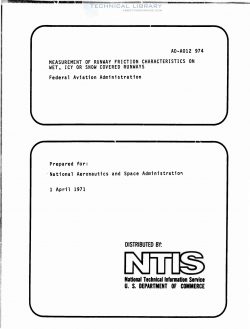DOT-FAA-FS-160-65-68-1
- Version
- 210 Downloads
- 1.83 MB File Size
- 1 File Count
- March 5, 2017 Create Date
- March 5, 2017 Last Updated
Measurement of Runway Friction Characteristics on Wet, Icy or Snow Covered Runways

In the 1950 decade, with the advent of the turbojet trans- ports, increased attention began to focus on the effects of vet runways on aircraft stopping distances. The FAA and NASA began wrk early in the 1960 decade to define the phenomena that cause reduced braking effect on vet Nnways. To date the FAA has issued Advisory Circular 91-6, Water, Slush and Snow on the January 1965; Advisory Circular 121-12, Wet or Slippery mxnwayg, August 1967; and FAR 121.195(d) . Although FAR 121.195(b) already required that the measured dry runway landing distance not exceed of the available runway length, FAR 121.195(d) , effective January 15, 1966, specified an additional 15% increase in required Nnvay length for forecast wet or Blippery runway conditions. The preamble to amendment 121-9 pointed out, however, that these factors are not expected to cover all possible adverse conditions, and that hazardous runway conditions be controlled in accordance with FAR 121.551 and 121.553. A significant of runway surface friction data hag been accumzlated, some of which show promise of corre- lation with aircraft stopping distances on wet, icy or snow-covered It tiæly, therefore, for the Federal Aviation Administration runways . to available pertinent data for to the aviation industry.
General. During the years 1967—1968 a joint effort by the FAA, NASA, the United Kingdom, several State highway departments, and others was undertaken to assees the correlation existing amng braking friction data obtained by 21 special test vehicles, by the F-4D jet fighter and CV-990 jet transport, and by several methods of predicting aircraft stopping distances on n.rnways. Tests were conducted on nine different nxnway surfaces under wet, puddled and flooded pavement conditions. Results of these tests, reported in Reference a, showed that the current methods used for predicting aircraft stopping distances on wet runways vas Inadequate. During the years 1968-1969 the FAA conducted a series of tests with the CV-880 jet transport and a James Brake Decelerometer to determine correlation under dry, wet, and 8 imalated icy runway conditions. Results, reported in Reference c , shoved poor correlation on damp and wet runways. From all of the test data accumalated to June I, 1970 three friction measurement devices emerge as having potential for use in conjunction with air carrier operations. these devices are:
| File | Action |
|---|---|
| DOT-FAA-FS-160-65-68-1 Measurement of Runway Friction Characteristics on Wet, Icy or Snow Covered Runways.pdf | Download |

Comment On This Post